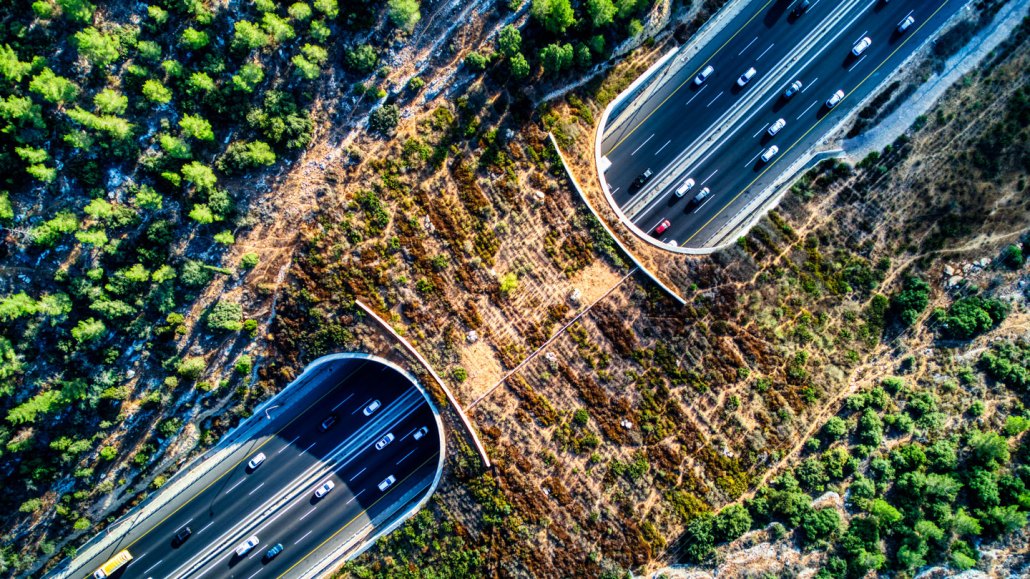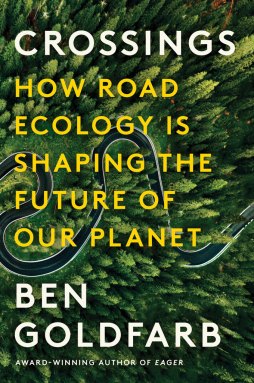‘Crossings’ explores the science of road ecology
Author Ben Goldfarb discusses his latest book

Wildlife crossings, like this bridge in Israel, offer animals safe passage across busy highways.
Hagai Agmon-Snir/Wikimedia Commons (CC BY-SA 4.0)

Crossings
Ben Goldfarb
W.W. Norton & Co., $30
Nearly 65 million kilometers of roadway crisscross the Earth — enough to encircle the planet more than 1,600 times — and that number will likely double by 2050. These roads have intruded into even the most remote corners of the world, and that has come at a cost: Vehicles are responsible for a staggering number of animal deaths. For instance, 1 million vertebrates are thought to die daily in collisions in the United States alone. Roads also kill indirectly, in part by fracturing migration routes and degrading pristine habitat.
In Crossings, journalist Ben Goldfarb delves into the burgeoning field of road ecology and introduces the impassioned, sometimes eccentric scientists who invite us to perceive our roads as animals do to better understand the ecological impacts. Goldfarb journeys alongside these researchers as they bike through Montana and wrestle anteaters in Brazil, squint at roadkill and rhapsodize about the design quirks that engineers can leverage to attract animals to safe overpasses and culverts. Road ecology, many of its proponents say, is a win-win: Building dedicated wildlife crossings, for example, is relatively cheap compared with other infrastructure projects, and minimizing collisions between drivers and animals preserves lives and lowers insurance premiums.
Science News spoke with Goldfarb about roads and how to minimize their harm. The following conversation has been edited for clarity and brevity.
SN: How did you get interested in road ecology? It seems very different from your previous book on beavers?
Goldfarb: The origins of this book date back to 2013, when I was on a reporting trip about habitat connectivity. I caught wind of wildlife crossings on Highway 93 in northern Montana, and I ended up taking a tour of them with Marcel Huijser, a wonderful road ecologist at the Western Transportation Institute in Montana.
The most powerful moment of that tour was when we moved to the one big wildlife overpass on Highway 93. The sun was going down on this beautiful October evening, and it was just incredibly inspiring to be on top of this piece of infrastructure that humans had built for wild animals. We do so much on this planet to make animals’ lives more difficult, and as a conservation journalist, it felt like a form of ecological empathy manifested as a science.
SN: You dedicate a lot of the book to small animals like reptiles, amphibians, insects and fish. Is that where the science led you?
Goldfarb: It’s where the field of road ecology is going in a lot of ways. A lot of the early history is focused on deer because that’s what safety-oriented engineers worry about. But as the field has evolved [to become more focused on conservation than human safety], it’s gotten more concerned with less charismatic, less dangerous organisms. They are important to think of because in some ways they’re the taxa most harmed by roads.
SN: How has this book changed your perceptions of roads?
Goldfarb: One of the biggest takeaways is just how deleterious road noise pollution is. When you read the literature about the health effects and the ecological effects of road noise, you realize that it’s truly one of the great unsung public health crises of our time. It’s elevating our cortisol levels, raising our blood pressure, and making us more susceptible to cardiac disease and stroke.
SN: You make a lot of comparisons between roads and climate change and the actions that are needed to address them.
Goldfarb: The climate movement has evolved a lot over the last decade away from individual blaming and towards indicting larger corporate power structures. The same holds true in the world of road ecology. Most of us have had the experience of hitting wild animals. I’ve killed animals, unfortunately, and I always feel incredibly guilty about it and complicit in this car culture. But car culture is the product of this very intensive marketing campaign that the whole automotive industrial complex has waged.
Instead of blaming drivers for roadkill, the real answers are these larger systemic solutions. Maybe that’s modifying infrastructure to build more wildlife crossings to make highways permeable; maybe it means improved mass transit systems.
SN: You end the book talking about how roads have been leveraged as a tool of oppression against Black and brown communities. Why was it important to include that aspect?
Goldfarb: The parallels between the ways that roads impact ecological communities and the ways they impact human communities are striking. Highways are forces of division in both ecosystems and cities, and we humans fall victim to cars, just as wild animals do. But I also wanted to recognize that we’re not all harmed equally — roads, especially urban freeways, have been very deliberately weaponized against communities of color throughout the last century. And that’s still happening today.
SN: You quote an early U.S. Forest Service employee as saying “roads are such final and irretrievable facts,” yet the book argues that roads can be made into “visitors” in a landscape.
Goldfarb: We have the capacity to change them. The Forest Service, one of the world’s largest road managers, is decommissioning thousands of roads, recognizing that they still have harmful ecological effects. On the other end of the spectrum, you have places like Syracuse, where an urban freeway was punched through the middle of the city, deliberately wiping out a Black neighborhood. This old viaduct will be torn down in recognition of the disproportionate harms that it inflicted on people of color.
It’s remarkable to think that everything from tiny dirt roads to this enormous urban freeway are being unmade. Our roads aren’t necessarily fatal, permanent mistakes after all.
Buy Crossings from Bookshop.org. Science News is a Bookshop.org affiliate and will earn a commission on purchases made from links in this article.






